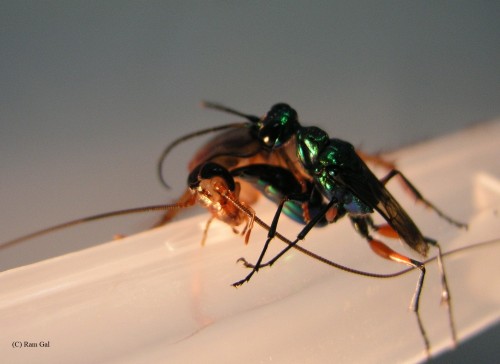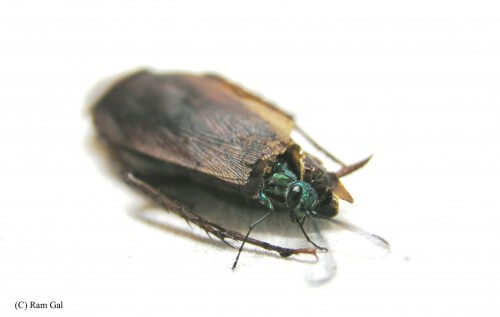Uni' Ben-Gurion researchers have discovered how the "Jewel Leap" uses special sensors scattered on its sting to inject venom directly into the brains of cockroaches.

Brain surgery is usually a fairly complicated process, unless it's a parasitic wasp that takes a keen interest in a cockroach's brain.
Brain surgery is usually a rather complicated process; Unless it is a parasitic wasp of the ampholex type, and the brain it is interested in belongs to a cockroach. A group of researchers led by Prof. Frédéric Libersat and Dr. Ram Gal from Ben-Gurion University of the Negev recently discovered that the Ampulex compressa wasp, better known as the "Jewel Wasp" due to its bright colors, uses special sensors scattered on its stinger to inject venom directly into The minds of cockroaches.
The tiny wasp uses cockroaches as a live food source for its offspring. She takes over the cockroach (which is significantly bigger than her) by biting it and injecting venom directly into its brain. The venom brings about a fascinating behavioral change in the stinging cockroach, which loses its "free will" after the sting and becomes a kind of slave to the wasp. That way, the cockroach doesn't try to resist the wasp or run away from it while it grabs one of its tentacles and leads it to its nest as if it were a dog on a leash. The wasp takes the cockroach into the nest, where it waits patiently while she lays a single egg, sticks it to the cockroach's leg, then seals the nest with leaves and small stones, and leaves. The cockroach, still fully alive but under the influence of the venom, does not try to resist or escape from the nest even while the wasp larva hatches from the egg, feeds on the cockroach for several days and then incarnates in its stomach.
In an article recently published in the scientific journal PLoS One, the researchers were interested in knowing how the parasitic wasp finds the cockroach's brain in order to inject the "enslaver" venom into it. Using an electron microscope, the researchers found tiny sensory organs, a thousandth of a millimeter in size, scattered on the stinger. When the researchers implanted an electrode inside the wasp's nervous system, they discovered that these "sensors" are sensitive to physical contact. For example, the sensors showed a strong response when the stinger was inserted into a "dummy brain", made of a material similar to rubber and reminiscent in shape and density of a cockroach's brain. These results raised the hypothesis that the wasp "feels" its way inside the cockroach's head using these sensors, until it finds the brain. To prove this, the researchers removed the cockroach's real brain and replaced it with a "dummy brain"; Indeed, the wasp did not notice the difference and injected the venom directly into the "dummy brain". In contrast, when the cockroach's brain was replaced with a "dummy brain" made of softer rubber than the real brain, or when the entire cockroach brain was removed or ground up inside the cockroach's head, the wasp immediately noticed the difference and refused to inject the venom.

The study demonstrates evolutionary adaptation at its best; The sensory organs on the wasp's sting have evolved, over millions of years of evolution, to differentiate between the different tissues inside the cockroach's head and to identify its brain. Thus, in less than a minute, these "brain sensors" allow the wasp to perform a complicated operation and inject venom directly into his brain, when instead of a surgical knife it uses a stinger that is only two millimeters long.
From the article published in the scientific journal PLoS One
More of the topic in Hayadan:

6 תגובות
Noam,
The moral is that we must continue to investigate to discover more such parables, and maybe in the end we will be able to save ourselves from them
MouthHole
We have no way of knowing what the development path was, of course, but it is easy to think of intermediate stages. for example:
1) At first, the wasp only bit the cockroach to devour it. The proteins in the cockroach provided a more readily available source of energy than eating the plant.
2) A chemical substance was formed in the wasp that damaged the nervous system of the cockroach. This made it easier to prey on cockroaches.
3) Because of the wasp's killing efficiency, it left residue.
4) The closer the wasp laid her eggs to the cockroach - the more offspring survived.
5) Live food is better than a carcass, so with the cockroach it was only paralyzed - it was an advantage for the offspring.
6) and so on.
It sounds morbid, but it's less morbid than thinking that someone planned it 🙂
I was happy that they mentioned evolution in the article, but I was disappointed that they did not elaborate. How did the venom develop into such a complex mechanism? It's very interesting. What was the poison before? What 'stairs' did the poison go through until it reached its current configuration. If anyone knows, I would appreciate an explanation.
Thanks
Miracles
Only a wise and benevolent creator could think of such cruelty....
The ultra-Orthodox are the hornet and we are their roaches. Moral.